Behind the scenes: First Flight helicopter crew saves lives during Space Coast emergencies
Whirring across Space Coast skies, Health First's medical helicopter crew rushes to trauma scenes at up to 150 mph to provide lifesaving care for people critically injured in violent vehicle crashes.
Victims of brutal assaults. People who collapse with life-threatening strokes.
And what First Flight manager Rob Spivey calls Brevard County's No. 1 most-common traumatic injury: falls by people age 55 and older.
“This is our new aircraft. It is beautiful, shiny, new — smells like a new car," flight paramedic April Inganna said, standing alongside the purple-and-white Eurocopter EC135 P2+ inside its base hangar.
“What we have in the aircraft is pretty much everything that you would find in an ambulance — and then some," Inganna said.
More: Remnants of long-lost blockhouse from 1st Florida rocket launch unearthed by UCF students
More: Is Palm Bay's 'Compound' an outdoorsman's paradise, or a dangerous haven for criminals?
"We have a ventilator, a heart monitor, a defibrillator. We have equipment to intubate a patient with a breathing tube, some special equipment to help us out with the airway: a video laryngoscope," she said.
Operated by Metro Aviation, Brevard's "air ambulance" transports about 800 patients a year, responding to emergency calls across Brevard, Osceola and Indian River counties, Spivey said. A three-person crew flies aboard: a pilot, a nurse-paramedic and a paramedic, with many transports ending at the Holmes Regional Medical Center trauma center.
Crammed with equipment and supplies, the helicopter is designed to carry one patient lying on a white stretcher. One of the two medical crew members remains positioned in the "airway seat" — within easy reach of the patient's head — to ensure that the patient continues breathing, Inganna said.
Working in cramped quarters aboard First Flight, Spivey said the two medical crew members use a priority-based algorithm to manage patient care.
"A lot of choreography is practiced. So if I'm the primary, I know what I'm doing. I'm starting IVs, I'm administering medications. If John (Cilladi, a nurse-paramedic) is secondary, he manages the airways. He's the one that would protect your airway and help you breathe, if needed," Spivey said.
"And then we switch every call," he said.
'An aircraft isn't a truck'
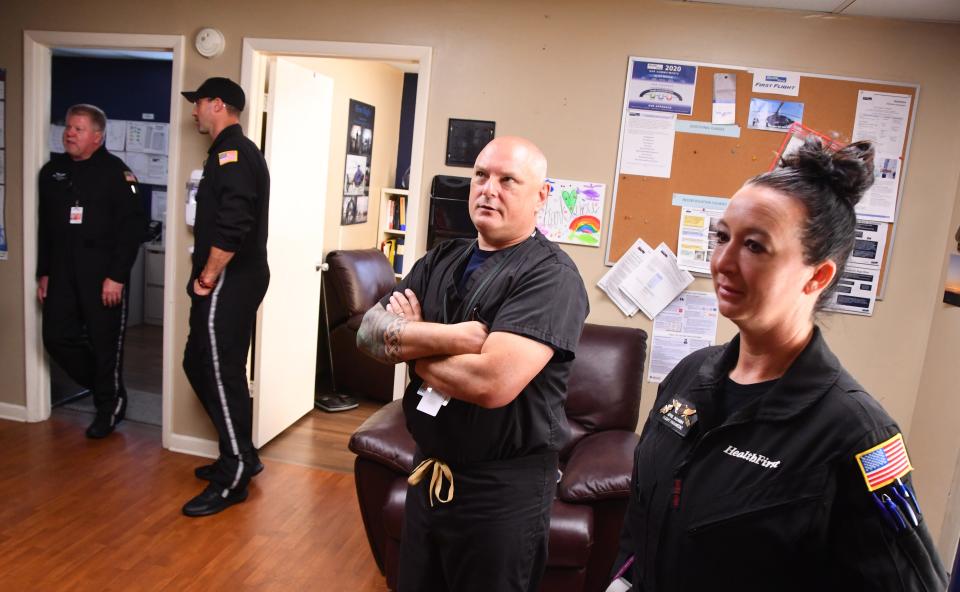
First Flight medical personnel work 24-hour shifts at modestly appointed Hangar 18, which includes three bedrooms, storerooms and an office at the north side of Melbourne Orlando International Airport — “we don’t really have a kitchen,” Spivey quipped.
The team includes four Metro Aviation pilots, four helicopter mechanics and 12 crew members boasting close to 250 combined years of critical-care experience, Spivey said.
Hospital-transfer patient trips, such as high-risk maternity mothers and cardiac patients, can range geographically as far south as Miami, as far north as Jacksonville, and as far west as Florida's Gulf Coast.
Measuring 33 feet long and weighing more than 3,200 pounds, the Eurocopter takes off and lands atop a wheeled rectangular platform. An orange Kubota tractor pushes and pulls the platform in and out of the hangar before and after flights.
Spivey said Metro Aviation acquired the 2010 Eurocopter EC135 P2+ from Germany in June 2022 for roughly $5 million. Originally built as a corporate aircraft, the helicopter sported leather seats and luxurious appointments.
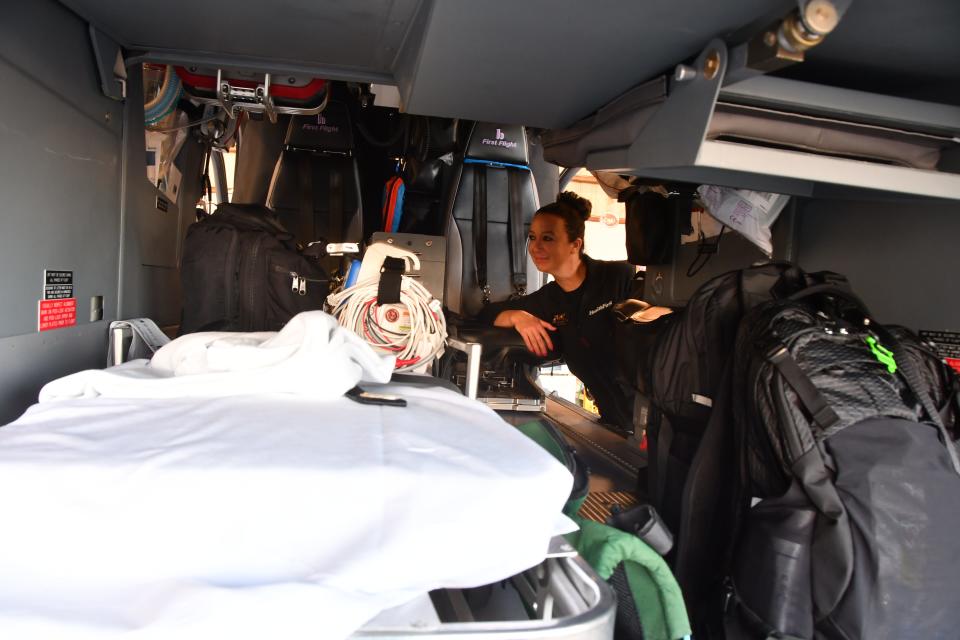
The Eurocopter spent six months getting retrofitted as a medical helicopter in Shreveport, Louisiana, before arriving Feb. 25 in Brevard. The twin-turbine-engine helicopter replaced First Flight's previous warhorse 1999 EC135, which Spivey said had racked up more than 11,500 hours on its airframe.
Spivey said the helicopter typically lifts off 8 to 10 minutes after dispatchers issue an emergency call. In sequence, crew members perform a "walk-around" to inspect the aircraft, load up gear, run through pre-flight checklists and request flight clearance from the control tower.
"On the ground, a fire truck can just turn the keys, go out the bay and start driving, right? Here, there's a system of checks that we have to do," Spivey said.
"And an aircraft isn't a truck. It takes some time to start up. There's a lot of systems that have to balance and work together and talk to each other before it's safe to get out," he said.
During a FLORIDA TODAY interview, a courier carried a blue medical-grade cooler inside the hangar's living quarters, and Spivey signed a clipboard. The cooler contained Type O whole blood. In May, First Flight became Florida's first air ambulance to start carrying whole blood during missions.
Wary eye for birds, utility lines
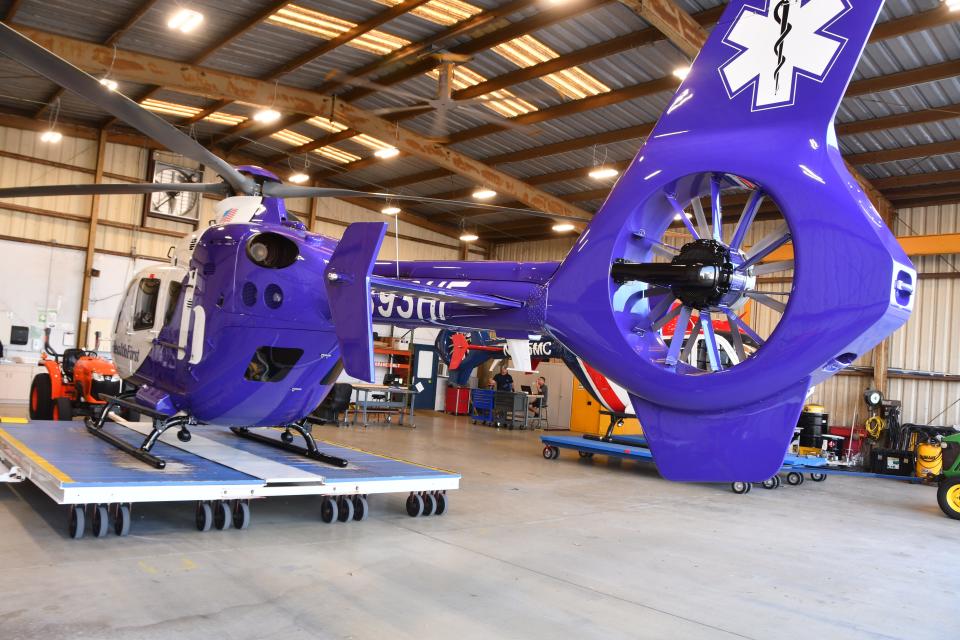
Pilot Chris Sands typically sits at a desk at the hangar monitoring weather reports — "it's a weather junkie thing," he said, laughing.
Sands previously logged a 29-year career with the Brevard County Sheriff's Office, most notably as a pilot in the aviation unit based at Merritt Island Airport. After retiring in 2017, he started piloting the First Flight helicopter.
"We have to check at all times. If we get a call, it can look beautiful here. But where we're going, there's weather that's not safe to fly in. We have to make sure we can fly that full circle of transit and be able to do it safely," he said.
Wearing a black jumpsuit, Sands flew FLORIDA TODAY on a brief First Flight "touch-and-go" ride from the airport hangar to the rooftop heliport at Holmes Regional Medical Center.
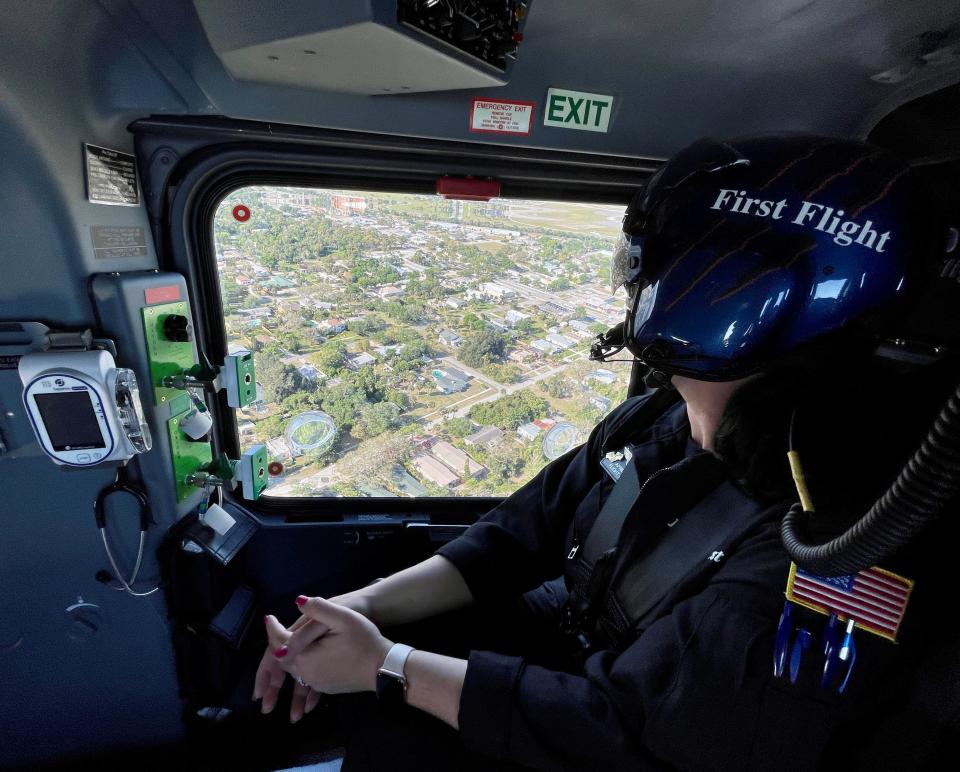
The Eurocopter's whirling blades kicked up mini-clouds of grass clippings as it slowly hovered aloft just west of the Embraer Executive Jets manufacturing complex, then flew east to the Indian River Lagoon.
Turning south, the aircraft passed the Compass Landing by Margaritaville resort construction site off U.S. 1, then headed inland and slowly eased toward the hospital's industrial-looking gray concrete landing pad before touching down.
"Flight com, safe on deck at Holmes," Sands said in his helmet's radio microphone.
Back at the hangar, Sands described a key piloting challenge: Whereas airport GPS beacons typically guide pilots to their destination, the medical helicopter must land on Interstate 95, grassy fields and random locations.
For example, when a single-engine Beechcraft Bonanza plane crash-landed March 14 near U.S. 1 north of Scottsmoor, the First Flight team landed in a nearby cow pasture.
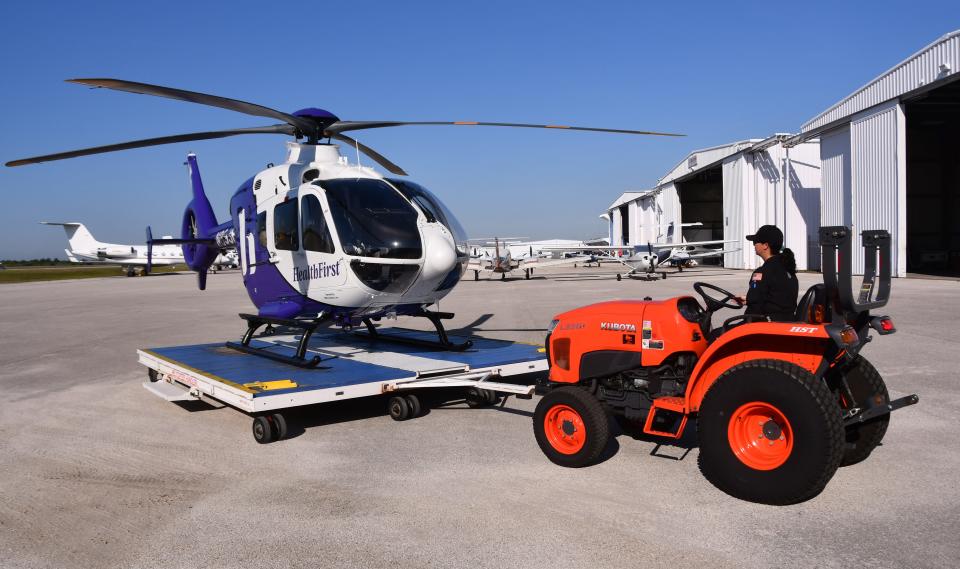
"You're really flying on-the-fly, so to speak. So we rely on the ground (personnel) to secure us a place to land, an LZ, a landing zone. We have to watch out for obstacles and hazards," Sands said.
Chief among them: utility lines, birds and vehicle-crash debris that the helicopter's powerful "rotor wash" can send flying as dangerous missiles.
The program debuted in 1988 as Care Flight, an on-call service that flew a few patients per week. Today's 24-7 operation dates to 1999. That's when Holmes Regional Medical Center earned state accreditation as the lone Level II trauma center in Brevard and Indian River counties.
Crews have used night-vision goggles since 2011 to help avoid hazardous wires and birds. Within the past 25 years, he said three bird strikes have caused "significant damage" to the aircraft.
In 2009, a bird crashed through the First Flight windshield just a few minutes from its destination, Arnold Palmer Hospital for Children in Orlando. The crew was transporting a 22-day-old infant.
Emotional toll of critical trauma
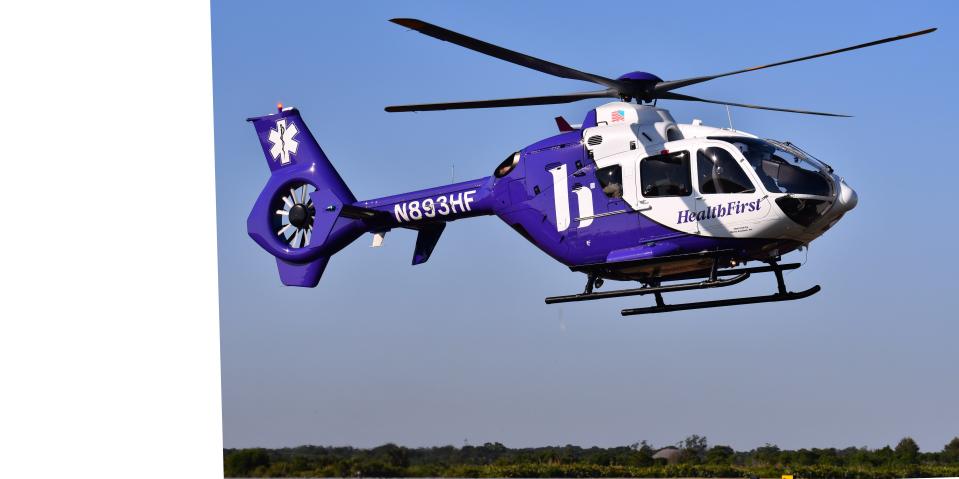
Cilladi has a passion for EMS. The nurse-paramedic started work in 2005 with the Myrtle Beach Fire Department in South Carolina. He took a job at Orlando Regional Medical Center in 2011, then joined Health First two years later.
"It always attracted me, because it seemed that they were getting the most-critical of the patients," Cilladi said of medical helicopters. "Since I've started, I've always been wanted to be involved in that aspect."
Inganna said she hopes to someday deliver presentations at EMS conferences on trauma psychology, particularly for children and adolescents. She labeled flight paramedics "master disassociaters" who swoop into bloody, high-stress scenes.
"I think a lot of times, we're robots. We get the call. We respond, treat the patient, drop them off. And I think a lot of paramedics, ground or air, don't realize the emotional impact that getting into a car accident, or your husband having a heart attack or stroke, has on the patient and the family," Inganna said.
"So along with patient care, I try to recognize the behaviors of the child, of the parent, the wife, husband, whatever. I try to tend to their emotional needs as well," she said.
"Because your bones heal. Your skin heals. The cath lab fixes your heart. But that scary and traumatic time in your life could take years to heal, as far as the emotional side goes," she said.
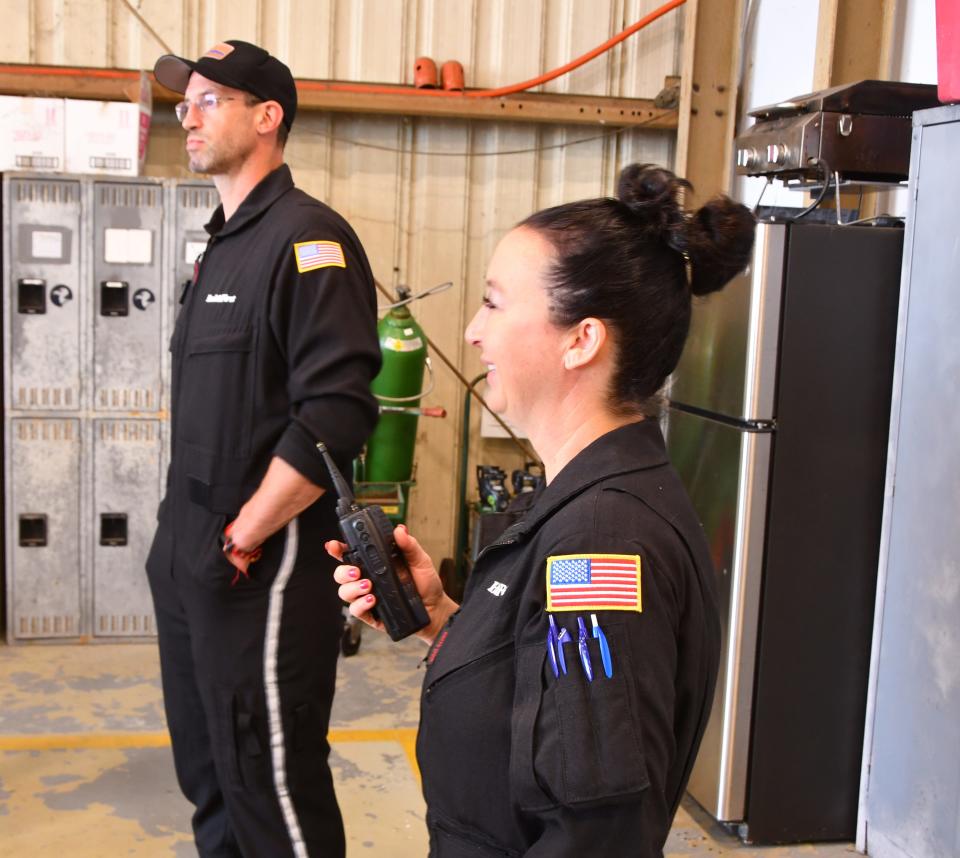
Inganna said the most difficult emergency calls for her to deal with are the preventable ones.
"Teenagers not wearing seat belts. The parents not belting in their children, and they fly out car windows. The drownings: not watching your kid, living in Florida and not getting your child swim lessons," Inganna said.
"So that's difficult. That's frustrating," she said.
Rick Neale is the South Brevard Watchdog Reporter at FLORIDA TODAY (for more of his stories, click here.) Contact Neale at 321-242-3638 or rneale@floridatoday.com. Twitter: @RickNeale1
Support local journalism. Subscribe today.
This article originally appeared on Florida Today: Behind the scenes: Health First medical helicopter crew saves lives

